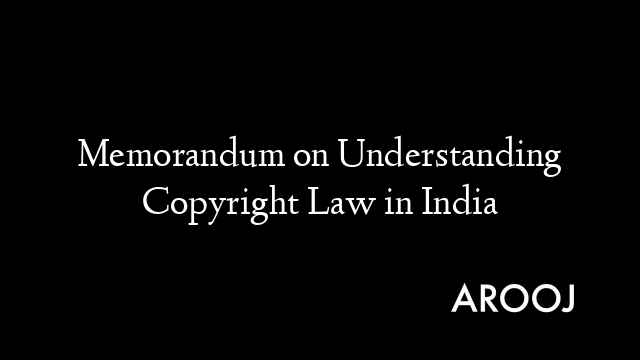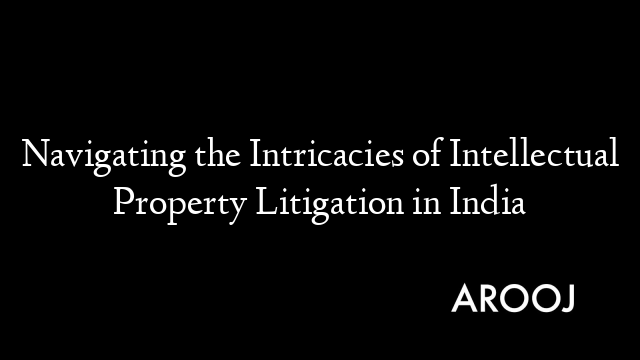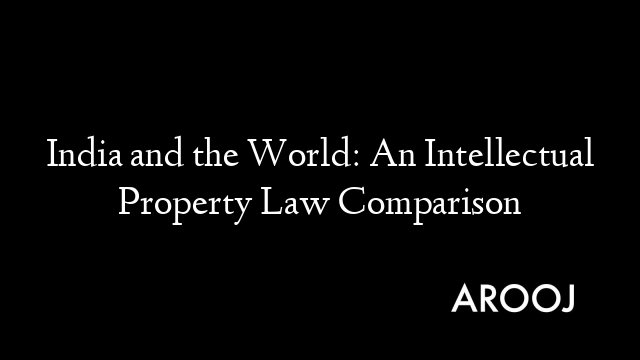Contents
- 1 I. Introduction to Intellectual Property Rights
- 2 II. Historical Evolution of Intellectual Property Rights in India
- 3 III. Types of Intellectual Property Rights
- 4 IV. Regulatory Framework and Authorities
- 4.1 Overview of Key IP Legislation in India
- 4.2 The Patents Act, 1970
- 4.3 The Trademarks Act, 1999
- 4.4 The Copyright Act, 1957
- 4.5 The Designs Act, 2000
- 4.6 The Geographical Indications of Goods (Registration & Protection) Act, 1999
- 4.7 Role of Intellectual Property Offices in India
- 4.8 Functioning of the IP Appellate Board
- 5 V. Intellectual Property Registration Process in India
- 6 VI. Enforcement of Intellectual Property Rights
- 7 VII. Intellectual Property Rights and Technology
- 8 VIII. Intellectual Property Rights and Business
- 9 IX. Challenges and Future Directions
- 10 X. Thoughts
This memorandum aims to provide a comprehensive overview of the basics of Intellectual Property Rights in India, intending to demystify the legal and procedural landscape for IP protection, management, and enforcement. Targeting both legal professionals and non-specialists, the document seeks to elucidate the various forms of IP, the existing legal framework, the processes involved in securing and enforcing these rights, and the current challenges and opportunities within the Indian context. The scope of this memorandum encompasses a detailed examination of India’s IP rights ecosystem, providing insights into its historical evolution, regulatory bodies, registration processes, enforcement mechanisms, and the impact of IP on business and technology. Through this exploration, the memorandum endeavors to highlight the critical role of IP rights in fostering an environment conducive to innovation and creativity, contributing significantly to India’s growth and development in the global arena.
I. Introduction to Intellectual Property Rights
Definition and Significance of Intellectual Property (IP)
Intellectual Property (IP) represents a range of intangible assets and creations of the mind for which a set of exclusive rights are recognized under the law. These assets can include inventions; literary and artistic works; designs; symbols, names, and images used in commerce. The primary significance of intellectual property rights is to encourage the creation of a wide variety of intellectual goods by giving creators certain rights to their creations. This, in turn, contributes to a wealth of knowledge and innovation, fostering further creative and economic growth. By protecting these assets, the law aims to incentivize individuals and organizations to continue investing in innovation and creativity, ensuring that creators can benefit from their inventions without the fear of misappropriation by others.
Overview of the Global Context of IP Rights
Globally, intellectual property rights are recognized as pivotal for the development and prosperity of nations. They play a critical role in the modern economy, enhancing competitiveness and contributing to the creation of jobs and wealth. The World Intellectual Property Organization (WIPO), a specialized agency of the United Nations, is dedicated to developing a balanced and accessible international IP system. The Agreement on Trade-Related Aspects of Intellectual Property Rights (TRIPS) is another cornerstone, administered by the World Trade Organization (WTO), which sets minimum standards for many forms of intellectual property regulation as applied to nationals of other WTO Members. This global framework underscores the universal recognition of the importance of IP rights in promoting economic and cultural development.
The Importance of IP Rights in India
In India, intellectual property rights are foundational to stimulating creativity and innovation across various sectors. The nation’s diverse cultural, scientific, and industrial landscape presents a fertile ground for creative and inventive activities. Protecting IP in India not only helps in recognizing and rewarding creators and inventors but also plays a crucial role in attracting foreign direct investment, boosting trade, and enhancing the socio-economic development of the country. With India’s growing emphasis on becoming a knowledge economy, the effective protection and enforcement of IP rights are imperative. This is evident in the government’s initiatives to streamline IP processes, raise awareness, and strengthen enforcement mechanisms to foster a culture of innovation and protect creators’ rights.
II. Historical Evolution of Intellectual Property Rights in India
Pre-colonial and Colonial Era Developments
The concept of intellectual property (IP) in India has roots that trace back long before the advent of colonial rule. Ancient texts, such as the Arthashastra, written by Kautilya in the 3rd century BCE, hint at the principles of protecting creators and inventors, suggesting a rudimentary understanding of IP rights. However, the structured legal framework for IP as known today began to take shape under British colonial rule. The British introduced the legal constructs of modern IP rights to India, establishing a system that mirrored their own to ensure that inventions and works from the colony could be controlled and monetized.
The first legislative action in this regard was the introduction of the Patent Act of 1856, modeled after the British Patent Law of 1852. This act marked the inception of the patent system in India, granting exclusive privileges to inventors for their inventions. However, it was criticized for catering more to British interests than fostering innovation within India. Subsequently, various acts and amendments were introduced to regulate copyright, trademarks, and designs, further laying down the foundation of the IP legal framework during the colonial era.
Post-independence Legislative Reforms
Following India’s independence in 1947, there was a pressing need to develop a legal system that reflected the newly sovereign nation’s values and priorities, including the sphere of intellectual property. The Indian government undertook significant legislative reforms to create an IP regime that balanced the promotion of innovation with the need for social welfare. The Patents Act of 1970 was a landmark piece of legislation in this regard, designed to suit the economic and technological landscape of post-independence India. It aimed at encouraging indigenous innovation and ensuring that patents contributed to the public good, introducing process patents in the fields of drugs and chemicals.
The Copyright Act of 1957 was another critical reform, providing protection to authors, composers, and artists, reflecting India’s rich cultural heritage. Similarly, the Trademarks Act of 1999 consolidated and amended the law relating to trademarks, aligning with the need to protect the identity of goods and services in the burgeoning Indian market. The Designs Act of 2000 further ensured the protection of industrial designs, promoting creativity in the industrial sector.
India’s Compliance with International IP Agreements (TRIPS, WIPO)
India’s integration into the global economy was accompanied by its accession to key international IP agreements, significantly influencing the evolution of its IP rights system. The Agreement on Trade-Related Aspects of Intellectual Property Rights (TRIPS), which India signed as a member of the World Trade Organization (WTO) in 1995, marked a turning point. TRIPS mandated the establishment of minimum standards for the protection and enforcement of IP rights for WTO member states, necessitating a series of legislative adjustments in India to comply with these standards. This included amendments to the Patents Act, introducing product patents in all fields of technology, including drugs and pharmaceuticals, and enhancing the protection terms in line with international norms.
Additionally, India’s engagement with the World Intellectual Property Organization (WIPO) has been pivotal in shaping its IP landscape. WIPO has provided a platform for India to engage in international IP policy discussions, and India has been a party to several WIPO-administered treaties, which have influenced the development and harmonization of its IP laws with international standards. These treaties include the Paris Convention for the Protection of Industrial Property, the Berne Convention for the Protection of Literary and Artistic Works, and others aimed at facilitating the international registration of trademarks, designs, and patents.
The historical evolution of intellectual property rights in India illustrates a journey from colonial legacies to a contemporary framework that seeks to balance national interests with global integration. Through significant legislative reforms and compliance with international agreements, India has established a robust IP regime that aims to foster innovation and creativity while ensuring that the benefits of intellectual property contribute to the broader public good.
III. Types of Intellectual Property Rights
Patents
Definition and Criteria for Patentability A patent is an exclusive right granted for an invention, which is a product or a process that provides a new way of doing something or offers a new technical solution to a problem. For an invention to be patentable, it must satisfy certain criteria: it must be of practical use; it must show an element of novelty, meaning that the invention is not known in the body of existing knowledge (prior art) in its technical field; and it must exhibit an inventive step which could not be deduced by a skilled person in the relevant technical field.
Process of Patent Application and Grant The process of obtaining a patent in India involves several steps, starting with the submission of a patent application to the Indian Patent Office. This is followed by an examination process where the application is scrutinized for compliance with patentability criteria. If objections are raised, the applicant has the opportunity to respond and amend the application. Upon satisfaction of the examination criteria, the patent is granted, and details of the grant are published in the Patent Office Journal.
Term of Protection and Renewal Process The term of protection for patents in India is 20 years from the date of filing the application. This term is not extendable except in the case of certain pharmaceutical products and agrochemicals, which can be extended for a maximum of five years under specific conditions. To maintain the patent, annual renewal fees must be paid from the third year of the patent being granted.
Trademarks
Significance of Trademarks for Businesses Trademarks are signs used by businesses to distinguish their goods or services from those of other enterprises. Trademarks are critical assets for businesses as they encapsulate the identity of the brand and its values, building trust and loyalty among consumers. They serve as a tool for effective communication, marketing, and brand recognition in a competitive market.
Registration Process and Legal Requirements In India, trademarks are registered under the Trademarks Act, 1999. The process involves filing an application at the Trademark Registry, where it is examined for any conflicts with existing or pending trademarks and for compliance with legal requirements. If objections are raised, the applicant has an opportunity to respond. Upon approval, the trademark is published in the Trademarks Journal. If there are no oppositions within the stipulated period, the trademark is registered and a certificate of registration is issued.
Protection Duration and Renewal The initial period of trademark registration in India is ten years, which can be renewed indefinitely for further periods of ten years each. Renewal requests can be filed within six months before the expiry of the current term of registration.
Copyrights
Types of Works Protected Under Copyright Copyright law in India protects original literary, dramatic, musical, and artistic works, cinematograph films, and sound recordings. Copyright ensures that creators have exclusive rights to use their works and authorize others to use them in specific ways.
Registration Process and Copyright Exceptions While copyright in India is automatic and does not require registration, registering a work can serve as prima facie evidence in a court of law in case of infringement. The Copyright Act provides several exceptions to copyright protection, including fair use for research, criticism, and education, among others.
Term of Copyright Protection The term of copyright protection in India varies: the life of the author plus 60 years for literary, dramatic, musical, or artistic works; 60 years from publication for cinematograph films and sound recordings; and 60 years from the year of publication for photographs and government works.
Designs
Definition and Eligibility Criteria A design in IP context refers to the features of shape, configuration, pattern, ornamentation, or composition of lines or colors applied to any article, making the article visually appealing. To be eligible for design protection, the design must be new and original, not previously published in India, and significantly distinguishable from known designs or combinations of known designs.
Registration Procedure and Term of Protection The process for registering a design in India involves filing an application with the Patent Office, which then examines the application for adherence to the eligibility criteria. Once approved, the design is registered and published in the Patent Office Journal. The term of protection for a registered design is 15 years, extendable by a further period of 5 years.
Geographical Indications
Importance and Criteria for Registration Geographical Indications (GIs) are signs used on products that have a specific geographical origin and possess qualities, a reputation, or characteristics inherent to that location. GIs play a crucial role in promoting agricultural and manufactured goods, often linked to traditional knowledge. For a product to be registered as a GI, it must be identifiable as originating from a specific place and possess qualities or a reputation due to that place of origin.
Protection Mechanism and Benefits The protection of a GI prevents unauthorized use of the registered GI by parties whose products do not conform to the applicable standards. This helps in safeguarding the interests of genuine producers and assists consumers in identifying authentic products. The benefits of GI registration include legal protection, prevention of misuse, and support for economic prosperity of the producers.
Trade Secrets
Legal Framework for Protection of Trade Secrets India does not have explicit legislation for the protection of trade secrets. Instead, trade secret protection is enforced through contracts and the Indian Contract Act, 1872, under the principles of confidentiality and non-disclosure agreements. Businesses must take proactive steps to safeguard their trade secrets through appropriate contractual measures with employees, partners, and others.
Enforcement of Rights and Remedies In cases of misappropriation or breach of confidentiality, the aggrieved party can seek civil remedies such as injunctions and damages. The enforcement of trade secrets primarily relies on the contractual obligations established between the parties involved.
This section of the memorandum provides an extensive overview of the different types of intellectual property rights available in India, highlighting their definition, registration processes, terms of protection, and renewal procedures. Each type of IP right serves a specific purpose in protecting the creations of the mind, contributing significantly to fostering innovation, creativity, and economic growth.
IV. Regulatory Framework and Authorities
Overview of Key IP Legislation in India
India has established a comprehensive legal and institutional framework for the protection of intellectual property rights (IPRs). This framework is designed to stimulate innovation, creativity, and technological advancement, contributing significantly to the country’s economic development and cultural enrichment. The cornerstone of this framework comprises several key pieces of legislation, each catering to a distinct form of intellectual property (IP). Together, these laws provide the legal basis for the protection and enforcement of IP rights in India.
The Patents Act, 1970
The Patents Act of 1970, along with its subsequent amendments, is the principal legislation governing the protection of patents in India. The Act provides for the grant of patents for inventions that are new, involve an inventive step, and are capable of industrial application. It outlines the process for obtaining a patent, the rights conferred by a patent, the duration of protection, and the mechanisms for the challenge and revocation of patents. The Act has been amended several times to meet the evolving international standards and India’s obligations under the Agreement on Trade-Related Aspects of Intellectual Property Rights (TRIPS).
The Trademarks Act, 1999
The Trademarks Act of 1999 governs the protection of trademarks in India. It offers a legal framework for the registration, protection, and enforcement of trademarks, ensuring that businesses can safeguard their brand identity and consumers can rely on the authenticity of goods and services. The Act defines what constitutes a trademark, the criteria for registration, the procedure for filing and opposition, and the rights and remedies available to the trademark owner. It also addresses the issues of trademark infringement and passing off, providing comprehensive protection for registered trademarks.
The Copyright Act, 1957
The Copyright Act of 1957 is designed to protect original literary, dramatic, musical, and artistic works, cinematograph films, and sound recordings. The Act confers exclusive rights on creators, such as the right to reproduce the work, communicate it to the public, make adaptations, and translate the work. It also specifies exceptions and limitations to copyright protection, including fair dealing for the purposes of research, criticism, review, and education, among others. The Act has been amended to align with international treaties and address the challenges posed by digital technology.
The Designs Act, 2000
The Designs Act of 2000 protects the visual design of objects that are not purely utilitarian. It covers features of shape, configuration, pattern, ornament, or composition of lines or colors applied to any article, whether in two-dimensional or three-dimensional form. The Act provides for the registration and protection of designs to encourage innovation and creativity in the industrial sector. It outlines the criteria for registrability, the registration process, the rights conferred by registration, and the remedies for infringement.
The Geographical Indications of Goods (Registration & Protection) Act, 1999
The Geographical Indications of Goods (Registration & Protection) Act of 1999 provides for the registration and better protection of geographical indications relating to goods. Geographical indications (GIs) are signs used on products that have a specific geographical origin and possess qualities, a reputation, or characteristics that are attributable to that origin. The Act aims to prevent unauthorized use of a registered geographical indication by others not originating from the designated geographical area, thereby protecting the interests of producers and promoting economic development.
Role of Intellectual Property Offices in India
The administration and enforcement of IP laws in India are primarily the responsibility of the Intellectual Property Offices, which operate under the Department for Promotion of Industry and Internal Trade (DPIIT), Ministry of Commerce and Industry. These offices include the Patent Office, the Trademarks Registry, the Copyright Office, and the Designs Registry. Each office is tasked with the registration, administration, and protection of the respective IP rights, facilitating the promotion of innovation and creativity across various sectors of the economy.
Functioning of the IP Appellate Board
The Intellectual Property Appellate Board (IPAB) was established to provide an efficient and expedited mechanism for the resolution of disputes related to IP rights. The IPAB hears appeals against the decisions of the Registrar under the Trademarks Act and the Geographical Indications of Goods Act, as well as appeals against the decisions of the Controller General of Patents, Designs, and Trademarks. The Board has the authority to adjudicate matters concerning the revocation of patents and the rectification of register entries, among other issues. The establishment of the IPAB has significantly contributed to the streamlining of IP dispute resolution in India.
This section has provided an overview of the regulatory framework and authorities governing intellectual property rights in India. Through the establishment of specific legislation for different types of IP and the creation of dedicated institutions for their enforcement and administration, India has built a robust IP regime. This regime not only protects the rights of creators and innovators but also promotes a culture of innovation and creativity, contributing to the country’s socio-economic development.
V. Intellectual Property Registration Process in India
Step-by-Step Guide for Registration of Each IP Type
Patents
- Preparation and Filing of Application: The first step is to prepare a detailed patent application, which includes a description of the invention, claims, abstract, and drawings if applicable. The application can be filed with the Indian Patent Office either online or offline.
- Publication: The application is published 18 months after the filing date or priority date, whichever is earlier, to make it publicly available.
- Request for Examination: After publication, a request for examination must be filed within 48 months from the priority date. The Patent Office then assigns an examiner to review the application.
- Examination and Response to Objections: The examiner issues a First Examination Report (FER) outlining any objections. The applicant has an opportunity to respond and amend the application to overcome these objections.
- Grant of Patent: If the application meets all requirements, the patent is granted, and the details are published in the Patent Office Journal.
Trademarks
- Trademark Search: Conduct a search in the Trademarks Registry to ensure that the trademark is unique and does not conflict with existing trademarks.
- Filing of Application: File an application with the Trademarks Registry. The application must include the trademark, the goods/services it will represent, and the applicant’s details.
- Examination Report: The Trademarks Office examines the application for any conflicts or objections. If there are objections, the applicant must respond satisfactorily.
- Publication in the Trademarks Journal: Upon acceptance, the trademark is published in the Trademarks Journal, allowing for any opposition by third parties.
- Registration: If there is no opposition or if the opposition is resolved in favor of the applicant, the trademark is registered, and a registration certificate is issued.
Copyrights
- Creation of Work: Copyright protection is automatic upon the creation of original literary, dramatic, musical, and artistic works, cinematograph films, and sound recordings.
- Registration (Optional): Though not mandatory, registration provides legal evidence of ownership. The application for registration can be filed at the Copyright Office, along with copies of the work.
- Issuance of Registration Certificate: After examination, if the Copyright Office finds the application in order, a certificate of registration is issued.
Designs
- Conducting a Search: Before filing an application, conduct a search to ensure the design is new and original.
- Filing of Application: Submit an application to the Designs Office, including drawings or photographs of the design and a brief statement of novelty.
- Examination: The Designs Office examines the application for conformity with the legal requirements.
- Registration: If the application is accepted, it is registered, and a certificate of registration is issued.
Geographical Indications
- Filing of Application: An application is filed by a representative body of the producers detailing the special characteristics of the product and its geographical origin.
- Examination: The Geographical Indications Registry examines the application for any deficiencies and compliance with the criteria.
- Registration: Upon satisfactory examination, the product is registered as a Geographical Indication, and a certificate is issued.
Common Challenges and How to Overcome Them
- Inadequate Research: Insufficient research before filing can lead to conflicts and objections. Solution: Conduct comprehensive searches and assessments to ensure IP uniqueness and compliance with legal requirements.
- Improper Documentation: Incomplete or incorrect documentation can delay or derail the registration process. Solution: Ensure meticulous preparation and review of all required documents and forms.
- Handling Objections: Receiving objections from the authorities or opposition from third parties can be challenging. Solution: Engage with IP professionals to craft strong responses and navigate the opposition process effectively.
Tips for Effective IP Management and Strategy
- Develop an IP Strategy: Align IP protection with your business goals and objectives, considering both current and future needs.
- Regular Monitoring: Keep track of your IP portfolio and the market to identify potential infringements or opportunities for licensing and collaboration.
- Use of Technology: Utilize IP management software to track filing deadlines, renewals, and to manage documents efficiently.
- Education and Awareness: Educate your team about the importance of IP rights and the need to protect confidential information and trade secrets.
- Professional Advice: Consult with IP attorneys or professionals for expert advice on registration, protection, and enforcement to navigate the complex IP landscape effectively.
The registration process for each type of intellectual property in India involves distinct steps tailored to the specific requirements of patents, trademarks, copyrights, designs, and geographical indications. While the process can present challenges, thorough preparation, research, and strategic planning can significantly mitigate these hurdles. By adopting effective IP management practices, businesses and individuals can safeguard their creative and innovative assets, contributing to their competitive advantage and long-term success.
VI. Enforcement of Intellectual Property Rights
Legal Remedies Available for IP Infringement
Intellectual property rights (IPR) enforcement in India encompasses a broad spectrum of legal remedies available to rights holders against infringement. These remedies are primarily judicial and are outlined in the respective IP legislations.
- Injunctions: Temporary (interlocutory) or permanent court orders to prevent further infringement.
- Damages or Account of Profits: Compensation for the loss suffered due to the infringement or an order for the infringer to hand over the profits made from the unlawful activity.
- Delivery up or Destruction: Orders for the infringing goods to be delivered up to the rights holder or destroyed.
- Criminal Remedies: Certain IP infringements, especially copyright and trademark violations, can lead to criminal prosecution, resulting in fines and imprisonment.
Role of Courts and Law Enforcement Agencies
The enforcement of IPR in India involves various judicial bodies and law enforcement agencies, each playing a crucial role.
- Courts: The High Courts and the Supreme Court of India have the authority to hear and decide on substantial IP disputes, including issuing injunctions and awarding damages. The District Courts also deal with IP infringement cases, subject to jurisdictional limits.
- Customs Authorities: Under the intellectual property rights (Imported Goods) Enforcement Rules, 2007, customs authorities can suspend the clearance of goods suspected of infringing intellectual property. This is a preventive measure to stop the import or export of infringing products.
- Police: In cases of copyright and trademark infringement, the police can take action under the provisions of the Indian Penal Code and specific IP legislations, registering FIRs, conducting raids, and making arrests based on complaints filed by the IP owner.
Notable IP Litigation Cases in India
India has witnessed several landmark IP litigation cases that have shaped the enforcement landscape and provided valuable jurisprudential insights.
- Novartis AG v. Union of India & Others: A landmark case where the Supreme Court of India denied patent protection to Novartis for its cancer drug, Glivec, under the Indian Patents Act. The case highlighted the strict standards applied by Indian law for granting patents, especially concerning pharmaceuticals, and emphasized the importance of balancing innovation with public health.
- Bajaj Auto Limited v. TVS Motor Company Limited: In this patent dispute, Bajaj Auto accused TVS Motor of infringing its patented technology. The case is significant for its discussion on the principles of patent infringement and the grant of injunctions.
- Amritpal Singh v. State of Punjab & Others: This copyright infringement case involving the unauthorized use of a photograph underscored the importance of copyright protection for photographers and the role of criminal law enforcement in copyright disputes.
Alternative Dispute Resolution Mechanisms
Given the often complex and prolonged nature of IP litigation, alternative dispute resolution (ADR) mechanisms like arbitration and mediation are becoming increasingly popular in India for resolving IP disputes.
- Arbitration: Allows parties to resolve disputes outside courts through an arbitrator or arbitration panel. It is suitable for commercial disputes, including those involving IP, where parties seek a binding resolution.
- Mediation: A non-binding process where a neutral mediator assists the parties in reaching a mutually acceptable settlement. It is favored for its ability to preserve business relationships and resolve disputes amicably.
- Conciliation: Similar to mediation, conciliation involves a conciliator who helps the parties to come to a resolution. Unlike mediation, the conciliator can propose a solution to the parties.
The use of ADR in IP disputes offers several advantages, including confidentiality, reduced costs, and time efficiency. It also allows for more flexible and creative solutions tailored to the specific needs of the parties involved.
Enforcement of intellectual property rights in India is multifaceted, involving a range of legal remedies, judicial bodies, law enforcement agencies, and alternative dispute resolution mechanisms. The robust legal framework and the evolving jurisprudence on IP enforcement underscore the country’s commitment to protecting and upholding intellectual property rights. This comprehensive approach not only deters infringement but also fosters a secure environment for innovation and creativity.
VII. Intellectual Property Rights and Technology
Impact of Digital Technology on IP
The advent of digital technology has had a profound impact on intellectual property rights (IPR), transforming how IP is created, distributed, and enforced. Digital technology has facilitated the creation of new forms of intellectual property, such as software, digital images, and multimedia content, while also providing tools for more efficient management of IP assets. However, it has also introduced challenges, particularly in terms of duplication and distribution. Digital content can be easily copied and shared, often without significant degradation in quality, making it difficult to control unauthorized use.
Moreover, digital technology has enabled the emergence of new platforms and business models, such as streaming services, digital marketplaces, and social media platforms, which have complicated the landscape of IP rights enforcement. These platforms can simultaneously act as avenues for copyright infringement and opportunities for monetizing IP. Consequently, there’s a pressing need for IP laws and enforcement mechanisms that are adaptable to the digital environment, balancing the interests of creators, consumers, and intermediaries.
Intellectual Property in the Software Industry
The software industry stands at the intersection of technology and IP, relying heavily on copyright, patents, and trade secrets to protect its products. Copyright law protects the source code and the user interface of software, recognizing them as literary works. Meanwhile, patents can protect software-related inventions that meet the criteria of novelty, inventive step, and industrial applicability. However, the patentability of software is a contentious issue, varying significantly across jurisdictions. The use of trade secrets is also prevalent in the software industry, protecting algorithms, designs, and business processes not disclosed to the public.
The protection of software IP is critical for fostering innovation and investment in the software industry. It ensures that developers and companies can recoup their investment in research and development, maintain competitive advantage, and continue to innovate. However, the dynamic and fast-evolving nature of software development poses challenges for traditional IP protection mechanisms, requiring a balance between protecting IP rights and promoting technological advancement and access to information.
Challenges of IP Protection in the Digital Age
The digital age has introduced several challenges to the protection of intellectual property, necessitating adaptation and innovation in IP management and enforcement strategies.
- Global Distribution and Jurisdictional Issues: The internet enables global distribution of digital content, creating challenges for enforcing IP rights across different jurisdictions with varying IP laws and enforcement standards.
- Rapid Technological Changes: The fast pace of technological advancement can outstrip existing IP laws and regulations, leading to legal uncertainties and gaps in protection.
- Digital Piracy: The ease of copying and distributing digital content has led to widespread digital piracy, significantly impacting industries like music, film, and software. Combatting digital piracy requires concerted efforts from governments, industries, and technology platforms.
- Open Source and Creative Commons: The rise of open-source software and Creative Commons licensing models challenges traditional notions of IP ownership and control. While they promote sharing and collaboration, they also raise questions about the sustainability of IP-based business models in certain sectors.
- Data Protection and Privacy: The collection and use of data in digital technologies intersect with IP rights, raising concerns about privacy, data protection, and the ownership of data-generated content.
Addressing these challenges requires a nuanced approach that embraces technological advancements, fosters innovation, and respects the rights of creators and the public. Strategies may include updating IP laws, enhancing international cooperation, leveraging technology for IP enforcement, and promoting awareness and education about IP rights in the digital age. The goal is to create an IP ecosystem that supports the dynamic nature of technological innovation while ensuring fair compensation and recognition for creators.
VIII. Intellectual Property Rights and Business
Importance of IP for Startups and SMEs
Intellectual Property (IP) serves as a critical asset for startups and Small and Medium-sized Enterprises (SMEs), providing them with a competitive edge in the fast-paced business environment. For these entities, IP can be a significant part of their valuation, attracting investment, and fostering partnerships and growth opportunities. Protecting IP enables startups and SMEs to safeguard their innovations, brand identity, and unique products or services, thus preventing competitors from unfairly capitalizing on their creativity and hard work.
Moreover, IP can be a revenue source through licensing, franchising, or selling IP rights, providing additional income streams beyond direct product or service sales. Effective IP management also enhances the marketability of startups and SMEs to potential investors, who often assess the robustness of a company’s IP portfolio when considering funding opportunities. It’s not just about protection but also about strategically using IP to secure a market position and navigate the path towards business expansion and sustainability.
Role of IP in Mergers, Acquisitions, and Collaborations
In mergers and acquisitions (M&A), IP assets often represent a significant portion of the deal value. IP due diligence is a crucial step in the M&A process, involving the assessment of the owned IP, its legal standing, and potential IP liabilities. This evaluation helps in determining the value of the IP assets, identifying risks, and negotiating terms that reflect the IP’s contribution to the business’s overall worth. A strong IP portfolio can enhance a company’s attractiveness as a merger or acquisition target, often commanding a premium in negotiations.
Similarly, in collaborations and partnerships, IP plays a pivotal role in defining the terms of engagement, particularly regarding the ownership, use, and commercialization of IP created jointly or shared between entities. Clear agreements on IP rights are essential to prevent conflicts and ensure that all parties benefit fairly from the partnership. This aspect is particularly crucial in industries where innovation and IP generation are continuous and collaborative efforts, such as technology, pharmaceuticals, and biotechnology.
Case Studies of Successful IP Commercialization in India
Bharat Biotech’s Covaxin: A prime example of successful IP commercialization in India is Bharat Biotech’s development and commercialization of Covaxin, India’s indigenous COVID-19 vaccine. The company collaborated with the Indian Council of Medical Research (ICMR) and the National Institute of Virology (NIV), pooling resources, knowledge, and IP to develop the vaccine in record time. This collaboration demonstrates the potential of public-private partnerships in leveraging IP for rapid innovation and addressing public health challenges.
Tata Consultancy Services (TCS): TCS has successfully leveraged its IP portfolio, particularly in software and IT solutions, to establish itself as a global leader in the information technology industry. The company has developed a range of proprietary products and platforms that contribute significantly to its revenue streams. TCS’s emphasis on innovation and IP protection has facilitated its growth and expansion into new markets, showcasing the strategic value of IP in the IT and services sector.
Amul: The dairy cooperative Amul, formally known as The Gujarat Co-operative Milk Marketing Federation Ltd. (GCMMF), has effectively utilized trademarks and brand management to become a leading food brand in India. Amul’s strategic use of IP rights in branding and marketing has played a crucial role in its commercial success, transforming it from a local cooperative to a global dairy giant. The Amul model of IP management highlights the importance of trademarks and brands in building consumer trust and loyalty, crucial for long-term business sustainability.
These case studies underscore the multifaceted role of IP in business, from fostering innovation and securing competitive advantages to facilitating mergers, acquisitions, and strategic partnerships. For startups, SMEs, and established corporations alike, a well-managed IP portfolio is not just a legal asset but a cornerstone of business strategy and value creation in today’s knowledge-driven economy.
IX. Challenges and Future Directions
Counterfeiting and Piracy Issues
Counterfeiting and piracy remain pervasive challenges undermining the intellectual property rights (IPR) framework in India and globally. These illicit activities not only result in substantial financial losses for rights holders but also compromise consumer safety, undermine the credibility of legitimate markets, and contribute to a loss of government revenues. The digital era has exacerbated these issues, making it easier to duplicate and distribute counterfeit goods and pirated content across borders with relative anonymity.
Combatting these challenges requires a multi-pronged approach, including stronger enforcement mechanisms, enhanced international cooperation, and the use of technology to track and authenticate products. Additionally, raising public awareness about the consequences of counterfeiting and piracy is crucial for reducing demand for illicit goods and protecting the integrity of IP rights.
Balancing IP Protection with Public Interest
A critical challenge facing India’s IP regime is balancing the protection of intellectual property rights with broader public interest considerations, such as access to medicines, education, and technology. This balance is particularly significant in the pharmaceutical sector, where patent protection can sometimes conflict with the need for affordable healthcare solutions.
India has sought to address this challenge through various provisions in its IP laws, such as compulsory licensing under the Patents Act, which allows the government to authorize the production of generic versions of patented medicines in the interest of public health. Moving forward, policies that continue to navigate this delicate balance will be essential, ensuring that IP protection encourages innovation while also safeguarding public access to essential goods and services.
The Impact of International Trade Agreements on India’s IP Regime
International trade agreements have a significant impact on India’s IP regime, often requiring adjustments to domestic IP laws to comply with international standards. Agreements under the auspices of the World Trade Organization (WTO), such as the Agreement on Trade-Related Aspects of Intellectual Property Rights (TRIPS), have necessitated reforms to India’s IP laws, particularly in terms of patent protection, enforcement measures, and the introduction of new IP rights.
While these agreements aim to harmonize IP protection globally, they also pose challenges, especially for developing countries like India, in terms of aligning with international norms while addressing domestic needs and development goals. India’s participation in future international trade agreements will need to carefully consider the implications for its IP regime, ensuring that commitments enhance rather than hinder national interests.
Future Trends and Policy Recommendations
As India continues to evolve its IP framework, several future trends and policy recommendations emerge:
- Strengthening IP Education and Awareness: Enhancing IP literacy among stakeholders, including inventors, creators, businesses, and the general public, can foster a culture of innovation and respect for IP rights.
- Leveraging Technology for IP Management and Enforcement: Adopting advanced technologies like blockchain for IP registration, tracking, and enforcement can increase efficiency and reduce instances of infringement.
- Enhancing Cross-Border Cooperation: Strengthening international collaboration for IP protection can help tackle global challenges such as counterfeiting and piracy more effectively.
- Encouraging Innovation and Access: Developing policies that incentivize innovation while ensuring that IP protection mechanisms do not unduly restrict access to essential goods and services, particularly in sectors like healthcare and education.
- Adapting to Digital Transformation: Updating IP laws and policies to address the challenges and opportunities presented by digital technologies and the internet economy is crucial for safeguarding IP rights in the digital age.
India’s approach to addressing these challenges and embracing future directions will significantly influence its success in building a robust, balanced, and innovative IP ecosystem. This will require ongoing dialogue among government, industry, academia, and civil society to ensure that India’s IP regime continues to support its broader socio-economic development goals.
X. Thoughts
The exploration of Intellectual Property Rights (IPR) in India, from its historical roots to contemporary challenges and future directions, underscores the critical role of IP in fostering innovation, creativity, and economic development. As we have navigated through the various facets of India’s IP regime, including the regulatory framework, types of IP, registration processes, enforcement mechanisms, and the interplay between IP and technology, several key points have emerged.
Firstly, India’s IP landscape has evolved significantly, reflecting a balance between adhering to international standards and addressing domestic needs. The legislative reforms and the strengthening of IP administration and enforcement mechanisms demonstrate India’s commitment to fostering an environment conducive to innovation. Secondly, the importance of IP for businesses, especially startups and SMEs, cannot be overstated. IP assets not only provide a competitive edge but also enhance the valuation and attractiveness of businesses to investors and partners. Moreover, the challenges posed by digital transformation and global integration necessitate a dynamic and responsive IP regime that can address issues such as counterfeiting, piracy, and balancing IP protection with public interest.
Strengthening IP rights is imperative for India’s economic and creative future. A robust IP regime can attract more investment in research and development, encourage innovation across sectors, and protect the creations and innovations that drive economic growth and cultural richness. Moreover, as India continues to integrate into the global economy, a strong IP framework will be essential in positioning the country as a leader in innovation and creativity on the world stage.
In conclusion, the journey towards an effective and balanced IP regime is ongoing, requiring the collective effort of all stakeholders, including the government, industry, academia, and civil society. There is a need for continued dialogue, education, and policy-making that considers the rapid changes in technology and the global economy. Stakeholders must work together to ensure that India’s IP policies not only protect rights holders but also foster an ecosystem that encourages innovation and creativity, driving sustainable economic growth and social development.
This memorandum serves as a call to action for all stakeholders to engage in the ongoing process of strengthening India’s IP regime. By doing so, we can ensure that intellectual property rights continue to serve as a cornerstone of innovation, creativity, and economic development in India, contributing to a brighter future for all.








